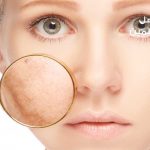
Since you got pregnant, you’ve been watching dark brown spots invade your face to the extent that they sometimes distract you from your belly, which is growing by the week into a little house.
Melasma (also known as the “mask of pregnancy”) is painless but “costly,” in terms of beauty, for a number of pregnant women, beginning in the fourth month of pregnancy. It’s one of the stubborn symptoms of pregnancy that accompany women for nine months and often even after delivery.
These spots are considered a quasi-natural state associated with pregnancy, especially in darker-skinned women, and are the result of elevated pregnancy hormones like progesterone and estrogen, which lead to an increase in the production of melanin in the skin.
But are there ways to help you avoid these spots that are invading your cheeks, nose, and forehead with chaotic brown splotches? Here are a few guidelines:
- The golden rule in combatting melasma is to maintain the highest degree of protection from UV radiation by wearing sunscreen with an SPF of 50 or higher.
- The risk of melasma increases when you go out during the peak hours of sunlight between noon and 5 in the afternoon, even if you are wearing sunscreen.
- Be careful to choose times to go out that are moderate in temperature, being mindful not to ignore the spring sun filtering through the clouds in the extremely hot Gulf countries.
- Overall food quality helps reduce the risk of melasma during pregnancy. A diet rich in vegetables and folic acid reduces the intensity of brown spots on your face.
Finally, anti-pigmentation medicines, in addition to regular peels, can be considered a final solution to problems with melasma, which may continue after delivery. Do this under the supervision of a dermatologist, who may decide to remove stubborn spots by means of a laser—though not in the summer!








